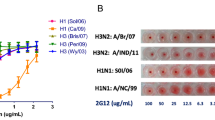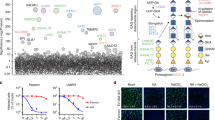Abstract
Oncolytic viruses are emerging as promising anticancer agents. Although the essential biological function of N-glycosylation on viruses are widely accepted, roles of N-glycan and glycan-processing enzyme in oncolytic viral therapy are remain elusive. Here, via cryo-EM analysis, we identified three distinct N-glycans on the envelope of oncolytic virus M1 (OVM) as being necessary for efficient receptor binding. E1-N141-glycan has immediate impact on the binding of MXRA8 receptor, E2-N200-glycan mediates the maturation of E2 from its precursor PE2 which is unable to bind with MXRA8, and E2-N262-glycan slightly promotes receptor binding. The necessity of OVM N-glycans in receptor binding make them indispensable for oncolysis in vitro and in vivo. Further investigations identified STT3A, a key catalytic subunit of oligosaccharyltransferase (OST), as the determinant of OVM N-glycosylation, and STT3A expression in tumor cells is positively correlated with OVM-induced oncolysis. Increased STT3A expression was observed in various solid tumors, pointing to a broad-spectrum anticancer potential of OVM. Collectively, our research supports the importance of STT3A-mediated N-glycosylation in receptor binding and oncolysis of OVM, thus providing a novel predictive biomarker for OVM.

This is a preview of subscription content, access via your institution
Access options
Subscribe to this journal
Receive 50 print issues and online access
$259.00 per year
only $5.18 per issue
Buy this article
- Purchase on Springer Link
- Instant access to full article PDF
Prices may be subject to local taxes which are calculated during checkout







Similar content being viewed by others
Data availability
The accession numbers for the cryo-EM density maps reported in this paper are Electron Microscopy Data Bank: EMD-31716, EMD-31717, EMD-31718, EMD-31719, and EMD-31720. The accession numbers for the atomic models reported in this paper are PDB: 7V4T and 7V4U.
References
Ribas A, Dummer R, Puzanov I, VanderWalde A, Andtbacka RHI, Michielin O, et al. Oncolytic virotherapy promotes intratumoral T cell infiltration and improves anti-PD-1 immunotherapy. Cell. 2017;170:1109–19.e1110.
Friedman GK, Johnston JM, Bag AK, Bernstock JD, Li R, Aban I, et al. Oncolytic HSV-1 G207 immunovirotherapy for pediatric high-grade gliomas. N Engl J Med. 2021;384:1613–22.
Hu J, Cai XF, Yan G. Alphavirus M1 induces apoptosis of malignant glioma cells via downregulation and nucleolar translocation of p21WAF1/CIP1 protein. Cell Cycle. 2009;8:3328–39.
Hu C, Liu Y, Lin Y, Liang JK, Zhong WW, Li K, et al. Intravenous injections of the oncolytic virus M1 as a novel therapy for muscle-invasive bladder cancer. Cell Death Dis. 2018;9:274.
Lin Y, Zhang H, Liang J, Li K, Zhu W, Fu L, et al. Identification and characterization of alphavirus M1 as a selective oncolytic virus targeting ZAP-defective human cancers. Proc Natl Acad Sci USA. 2014;111:E4504–4512.
Song D, Jia X, Liu X, Hu L, Lin K, Xiao T, et al. Identification of the receptor of oncolytic virus M1 as a therapeutic predictor for multiple solid tumors. Signal Transduct Target Ther. 2022;7:100.
Hasan SS, Sun C, Kim AS, Watanabe Y, Chen CL, Klose T, et al. Cryo-EM structures of eastern equine encephalitis virus reveal mechanisms of virus disassembly and antibody neutralization. Cell Rep. 2018;25:3136–47.e3135.
Pletnev SV, Zhang W, Mukhopadhyay S, Fisher BR, Hernandez R, Brown DT, et al. Locations of carbohydrate sites on alphavirus glycoproteins show that E1 forms an icosahedral scaffold. Cell. 2001;105:127–36.
Beasley DW, Whiteman MC, Zhang S, Huang CY, Schneider BS, Smith DR, et al. Envelope protein glycosylation status influences mouse neuroinvasion phenotype of genetic lineage 1 West Nile virus strains. J Virol. 2005;79:8339–47.
Acharya D, Paul AM, Anderson JF, Huang F, Bai F. Loss of glycosaminoglycan receptor binding after mosquito cell passage reduces chikungunya virus infectivity. PLoS Negl Trop Dis. 2015;9:e0004139.
Aksnes I, Markussen T, Braaen S, Rimstad E. Mutation of N-glycosylation sites in salmonid alphavirus (SAV) envelope proteins attenuate the virus in cell culture. Viruses. 2020;12:1071.
Watanabe Y, Bowden TA, Wilson IA, Crispin M. Exploitation of glycosylation in enveloped virus pathobiology. Biochim Biophys Acta Gen Subj. 2019;1863:1480–97.
Kelleher DJ, Karaoglu D, Mandon EC, Gilmore R. Oligosaccharyltransferase isoforms that contain different catalytic STT3 subunits have distinct enzymatic properties. Mol Cell. 2003;12:101–11.
Shrimal S, Trueman SF, Gilmore R. Extreme C-terminal sites are posttranslocationally glycosylated by the STT3B isoform of the OST. J Cell Biol. 2013;201:81–95.
Chen L, Wang M, Zhu D, Sun Z, Ma J, Wang J, et al. Implication for alphavirus host-cell entry and assembly indicated by a 3.5A resolution cryo-EM structure. Nat Commun. 2018;9:5326.
Ribeiro-Filho HV, Coimbra LD, Cassago A, Rocha RPF, Guerra J, de Felicio R, et al. Cryo-EM structure of the mature and infective Mayaro virus at 4.4 A resolution reveals features of arthritogenic alphaviruses. Nat Commun. 2021;12:3038.
Gavel Y, von Heijne G. Sequence differences between glycosylated and non-glycosylated Asn-X-Thr/Ser acceptor sites: implications for protein engineering. Protein Eng. 1990;3:433–42.
Ribeiro-Filho HV, Coimbra LD, Cassago A, Rocha RPF, Guerra JVD, de Felicio R, et al. Cryo-EM structure of the mature and infective Mayaro virus at 4.4 angstrom resolution reveals features of arthritogenic alphaviruses. Nat Commun. 2021;12:3038.
Watanabe Y, Allen JD, Wrapp D, McLellan JS, Crispin M. Site-specific glycan analysis of the SARS-CoV-2 spike. Science. 2020;369:330–3.
Zhou ZH, Dougherty M, Jakana J, He J, Rixon FJ, Chiu W. Seeing the herpesvirus capsid at 8.5 A. Science. 2000;288:877–80.
Zhang R, Hryc CF, Cong Y, Liu X, Jakana J, Gorchakov R, et al. 4.4 A cryo-EM structure of an enveloped alphavirus Venezuelan equine encephalitis virus. EMBO J. 2011;30:3854–63.
Basore K, Kim AS, Nelson CA, Zhang R, Smith BK, Uranga C, et al. Cryo-EM structure of chikungunya virus in complex with the Mxra8 receptor. Cell. 2019;177:1725–37.e1716.
Voss JE, Vaney MC, Duquerroy S, Vonrhein C, Girard-Blanc C, Crublet E, et al. Glycoprotein organization of chikungunya virus particles revealed by X-ray crystallography. Nature. 2010;468:709–12.
Rinis N, Golden JE, Marceau CD, Carette JE, Van Zandt MC, Gilmore R, et al. Editing N-glycan site occupancy with small-molecule oligosaccharyltransferase inhibitors. Cell Chem Biol. 2018;25:1231–41.e1234.
Kulkarni A, Ferreira T, Bretscher C, Grewenig A, El-Andaloussi N, Bonifati S, et al. Oncolytic H-1 parvovirus binds to sialic acid on laminins for cell attachment and entry. Nat Commun. 2021;12:3834.
Jayawardena N, Burga LN, Poirier JT, Bostina M. Virus–receptor interactions: structural insights for oncolytic virus development. Oncolytic Virother. 2019;8:39–56.
Zhang H, Lin Y, Li K, Liang J, Xiao X, Cai J, et al. Naturally existing oncolytic virus M1 is nonpathogenic for the nonhuman primates after multiple rounds of repeated intravenous injections. Hum Gene Ther. 2016;27:700–11.
Harrington K, Freeman DJ, Kelly B, Harper J, Soria J-C. Optimizing oncolytic virotherapy in cancer treatment. Nat Rev Drug Discov. 2019;18:689–706.
Ramelyte E, Tastanova A, Balazs Z, Ignatova D, Turko P, Menzel U, et al. Oncolytic virotherapy-mediated anti-tumor response: a single-cell perspective. Cancer Cell. 2021;39:394–406.e394.
Cheng RH, Kuhn RJ, Olson NH, Rossmann MG, Choi HK, Smith TJ, et al. Nucleocapsid and glycoprotein organization in an enveloped virus. Cell. 1995;80:621–30.
Fuller SD, Berriman JA, Butcher SJ, Gowen BE. Low pH induces swiveling of the glycoprotein heterodimers in the Semliki Forest virus spike complex. Cell. 1995;81:715–25.
Li L, Jose J, Xiang Y, Kuhn RJ, Rossmann MG. Structural changes of envelope proteins during alphavirus fusion. Nature. 2010;468:705–8.
Wang A, Zhou F, Liu C, Gao D, Qi R, Yin Y, et al. Structure of infective Getah virus at 2.8 A resolution determined by cryo-electron microscopy. Cell Discov. 2022;8:12.
Holmes AC, Basore K, Fremont DH, Diamond MS. A molecular understanding of alphavirus entry. PLoS Pathog. 2020;16:e1008876.
Cloughesy TF, Landolfi J, Vogelbaum MA, Ostertag D, Elder JB, Bloomfield S, et al. Durable complete responses in some recurrent high-grade glioma patients treated with Toca 511 + Toca FC. Neuro Oncol. 2018;20:1383–92.
Mastronarde DN. Automated electron microscope tomography using robust prediction of specimen movements. J Struct Biol. 2005;152:36–51.
Zheng SQ, Palovcak E, Armache JP, Verba KA, Cheng Y, Agard DA. MotionCor2: anisotropic correction of beam-induced motion for improved cryo-electron microscopy. Nat Methods. 2017;14:331–2.
Zhang K. Gctf: real-time CTF determination and correction. J Struct Biol. 2016;193:1–12.
Tang G, Peng L, Baldwin PR, Mann DS, Jiang W, Rees I, et al. EMAN2: an extensible image processing suite for electron microscopy. J Struct Biol. 2007;157:38–46.
Zivanov J, Nakane T, Forsberg BO, Kimanius D, Hagen WJ, Lindahl E, et al. New tools for automated high-resolution cryo-EM structure determination in RELION-3. eLife. 2018;7:e42166.
Guo F, Jiang W. Single particle cryo-electron microscopy and 3-D reconstruction of viruses. Methods Mol Biol. 2014;1117:401–43.
Henderson R, Sali A, Baker ML, Carragher B, Devkota B, Downing KH, et al. Outcome of the first electron microscopy validation task force meeting. Structure. 2012;20:205–14.
Scheres SH, Chen S. Prevention of overfitting in cryo-EM structure determination. Nat Methods. 2012;9:853–4.
Kucukelbir A, Sigworth FJ, Tagare HD. Quantifying the local resolution of cryo-EM density maps. Nat Methods. 2014;11:63–65.
Pettersen EF, Goddard TD, Huang CC, Couch GS, Greenblatt DM, Meng EC, et al. UCSF Chimera-a visualization system for exploratory research and analysis. J Comput Chem. 2004;25:1605–12.
Kelley LA, Mezulis S, Yates CM, Wass MN, Sternberg MJ. The Phyre2 web portal for protein modeling, prediction and analysis. Nat Protoc. 2015;10:845–58.
Emsley P, Cowtan K. Coot: model-building tools for molecular graphics. Acta Crystallogr D Biol Crystallogr. 2004;60:2126–32.
Adams PD, Afonine PV, Bunkoczi G, Chen VB, Davis IW, Echols N, et al. PHENIX: a comprehensive Python-based system for macromolecular structure solution. Acta Crystallogr D Biol Crystallogr. 2010;66:213–21.
Song H, Zhao Z, Chai Y, Jin X, Li C, Yuan F, et al. Molecular basis of arthritogenic alphavirus receptor MXRA8 binding to chikungunya virus envelope protein. Cell. 2019;177:1714–24.e1712.
Acknowledgements
We thank the members in cryo-EM facility center in medical school of Zhejiang University; SUSTech cryo-EM facility center, Southern University of Science and Technology; Dr. Zhe Liu in the Guangdong Provincial Center for Disease Control and Prevention, Guangdong Provincial Institute of Public Health; and Hongmei Li, Yinyin Li in School of Life Science for helps in data collection. Prof. Rui Zhang from Washington University, USA, for valuable suggestions regarding the manuscript. This work was supported by National Key R&D Program of China (2021YFA0909800), National Natural Science Foundation of China (82172730 and 81872887), Pioneering talents project of Guangzhou Development Zone, Guangdong Province (2020-L036), Guangdong Basic and Applied Basic Research Foundation (2023A1515012462 and 2021A1515011881), Leading team for entrepreneurship in Guangzhou, Guangdong Province (201809020004), and Science and Technology Planning Project of Guangdong Province, China (No: 2021B1212040017).
Author information
Authors and Affiliations
Contributions
DS, XJ, YL, and QZ developed original hypothesis and designed the experiments. XJ, YG, and QZ undertook the cryo-EM data collection and processing, reconstruction, map refinement, and atomic modeling. DS, TX, DJ, and YL designed and purified hMXRA8 protein and developed incubation conditions of virus and hMXRA8. DS, TX, and RS performed OVM virus infection experiments, drug screen, and binding ability assay. DS and YL engineered and purified OVM virus and deglycosylated mutants. DS, XJ, YG, and QZ performed data analysis. JC, JL, JH, WZ, and GY, supervised experiment and provide critical comments. DS, XJ, YL, and QZ, wrote the initial manuscript draft, with GY providing editorial suggestion.
Corresponding authors
Ethics declarations
Competing interests
The authors declare no competing interests.
Additional information
Publisher’s note Springer Nature remains neutral with regard to jurisdictional claims in published maps and institutional affiliations.
Rights and permissions
Springer Nature or its licensor (e.g. a society or other partner) holds exclusive rights to this article under a publishing agreement with the author(s) or other rightsholder(s); author self-archiving of the accepted manuscript version of this article is solely governed by the terms of such publishing agreement and applicable law.
About this article
Cite this article
Song, D., Jia, X., Gao, Y. et al. STT3A-mediated viral N-glycosylation underlies the tumor selectivity of oncolytic virus M1. Oncogene 42, 3575–3588 (2023). https://doi.org/10.1038/s41388-023-02872-7
Received:
Revised:
Accepted:
Published:
Issue Date:
DOI: https://doi.org/10.1038/s41388-023-02872-7



